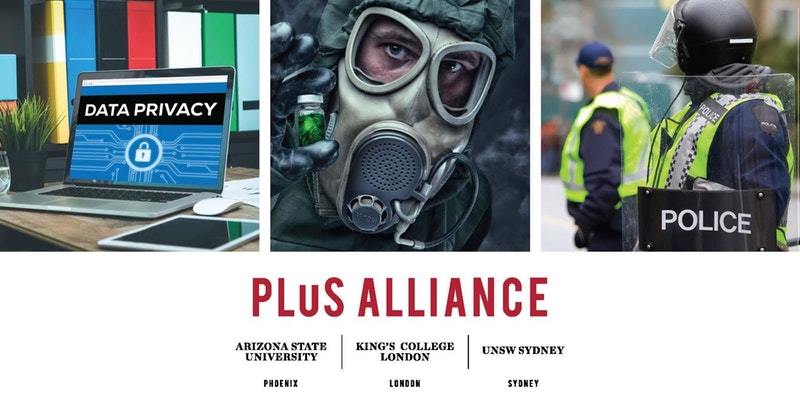
Against a backdrop of geopolitical instability, society is being transformed in unanticipated ways, with unprecedented levels of threat to security. War, terrorism, conflict and forced displacement of peoples pose international socio-political challenges even in the most stable of societies. The ‘war on terror’ has run for a longer period than World Wars I and II combined, and continues unabated with no likely end in sight. As a result, modern anti-terrorism laws have taken on a character of permanence, and will reshape society, creating new precedents, understandings, expectations and political conventions. In other areas of global impact such as rapidly emerging new technologies, laws and technical procedures to mitigate risk are either entirely absent or not fit for purpose.
Technological and scientific advances in computer science, biology, artificial intelligence and weaponry have occurred at a much faster pace than our legal and regulatory frameworks for maintaining security. Dual-use technology is that developed to benefit humanity, but which may also be used to harm humanity, either deliberately or by accident. The world is in uncharted territory, with no systematic means of risk-analysis of dual-use technology. These technologies, whether cyber, biological, artificial intelligence, nuclear, or new generation weaponry, are equally accessible to terrorist groups as they are for legitimate use. The convergence of such diverse security threats is an existential threat to human survival and cannot be addressed through traditional approaches. These threats cross national boundaries, and cannot be effectively managed either in the traditional disciplinary silos or by individual nation-states, but require coordinated research, thought leadership and novel, cross-disciplinary, global solutions.
War, terrorism and biological weapons of mass destruction
War and conflict continue to be the common feature of the human experience, but with advanced technology compared to previous conflicts. Compounding this, there are more displaced people and refugees in the world today than any time in history. The recent change that has upset the previous understanding war has been the advent of powerful non-state actors across the globe, using constantly changing methods of attack. This has challenged the fundamentals of the nation-state that has been the template for the modern understanding of war since the Treaty of Westphalia. The weapons used in war, conflict and acts of terrorism are also changing, including the use of drones and artificial intelligence in warfare. Changes have also occurred in methods used in terrorist acts, such as use of aircraft in 9/11, or the use of vehicles by homegrown violent extremists. Technology has led to quantum advances in biological and cyber weapons, which create new vulnerabilities.
Revolutionary new tools and technologies such as CRISPR Cas9, a precision gene editing capability, can equally benefit or harm humanity. Whilst CRISPR Cas9 enables cures to diseases, it also enables engineering of deadly viruses as weapons of mass destruction. Global planning for bioterrorism is still largely framed by the Cold War, within the limited scope of thinking around agents such as smallpox and anthrax. However, there is a vast array of other possible biological WMD which fall outside of the scope of such traditional thinking and planning. This emerging field has eliminated the mandatory requirement of access to a laboratory suite, for major research can be performed using mathematical models and genetic codes, with such information readily accessible. There is an unprecedented increase in the frequency of serious epidemics such as Ebola virus, avian influenza, MERS coronavirus and Zika virus in the last decade, which cannot be solely explained by environmental and ecological factors. Whether natural or unnatural, the risk of a pandemic is higher now than any time in the past, and requires new capability in risk analysis, prevention, detection and response.
 Cyberattacks, critical infrastructure and health security
Cyberattacks, critical infrastructure and health security
Cyber attacks can affect any aspect of societal functioning, from critical infrastructures, to banking and health. In the case of financial crimes, the outcome may be the loss of money or assets, or it could adversely affect confidence in the financial system and the markets that fuel the international economy. In the cases of critical infrastructures or health, the outcome may be loss of life, possibly at a grand scale. Cyberattackers have already successfully demonstrated the ability to take out major portions of a power grid – the 2015 attack on the Ukrainian electricity network knocked out power for several hours for approximately 225,000 customers.
Large-scale cyberattacks affect not only home conveniences and basic business continuity but also interrupt life saving interventions such as mechanical ventilation in intensive care units, or home oxygen for bed-bound patients in their homes. Backup generators, the common insurance for such systems, can fail as a result of poor design or placement, or as a result of a coordinated attack by others. The convergence of health security and cybersecurity is illustrated by recent ransomware attacks on hospitals, which are crippled when electronic systems fail and vital patient records, diagnostics and treatment histories cannot be accessed by healthcare practitioners. Worldwide, there has been an escalation of attacks on hospitals precisely because of critical dependence on information systems in an increasingly paperless environment, along with poor cyber security practices. Hacking allows hostile group to access the health information of individuals – their illnesses, medications, their doctor, scheduled surgery and so on, which provides new modus operandi of attack for organized crime or terrorist groups.
Democracy, law and countering violent extremism
Lawmakers around the world are grappling with how to best protect the community from terrorism. In legal terms, the challenge can be simply expressed: how can anti-terrorism laws be enacted that confer extraordinary powers upon government and its agencies, while at the same time not undermining the democratic freedoms we are seeking to protect from terrorism? Rather than fading away since 11 September 2001, this question has assumed even greater importance. If nothing else, it is clear that the response of democratic nations to terrorism is more than a temporary, emergency reaction to those and other catastrophic attacks, and to the possibility that such indiscriminate violence might be repeated at home. As the years have passed, it has become clear that anti-terrorism laws amount to much more than a transient, short-term response.
In many ways, this makes these laws of a greater significance than the exceptional measures found on the statute book during World Wars I and II. Those conflicts were of more definite duration, and wartime legal measures ceased to operate soon after the conflict ended. By contrast, modern anti-terrorism laws have taken on a character of permanence, as the so-called ‘war on terror’ continues unabated. While a few anti-terrorism laws are the subject of ‘sunset clauses’ that could see them lapse after a specified period of time, most have effect for an indefinite duration. All this points to the fact that anti-terrorism laws may be altered in the coming years, but will not likely be repealed. The realisation that extraordinary anti-terrorism laws are here to stay has important implications. We can expect that the inroads made into human rights by these laws will endure. In doing so, the laws create new precedents, understandings, expectations and political conventions when it comes to the proper limits of government power and the role of the state. Indeed, many anti-terrorism measures are becoming seen as normal rather than exceptional. This is due both to the passage of time and the fact that anti-terrorism strategies are being copied in other areas of the law. All this suggests that anti-terrorism laws are not themselves only shaped by human rights concepts, but in turn are shaping those concepts so as to bring about a historical shift in our understandings of liberty and security.
Global Security PLuS is an opportunity for academia, governments and industry to partner in a new way – join us on July 19th 2017.
This article is written by:
Professor Raina MacIntyre
Head, School of Public Health & Community Medicine, UNSW Sydney
Professor George Williams
Dean, UNSW Law, UNSW Sydney
Wes Herche
Global Security Initiative, Arizona State University
Professor Luca Vigano
Head, Department of Informatics, Kings College London
A/Professor David Heslop
School of Public Health & Community Medicine, UNSW Sydney and Australian Defence Forces
Chief Thomas Engells
University of Texas Medical Branch and UNSW SPHCM







